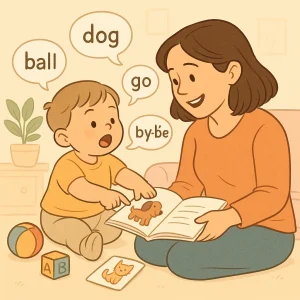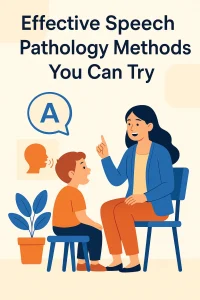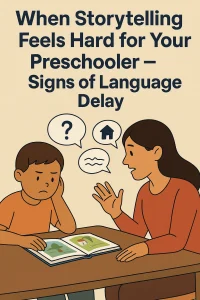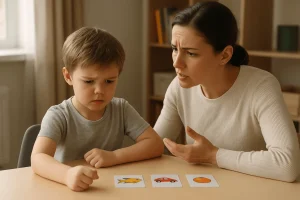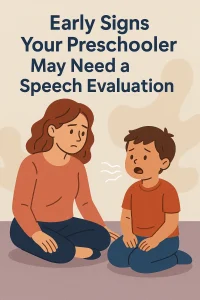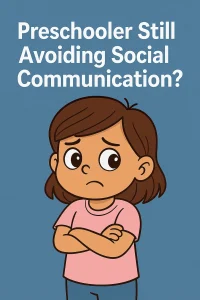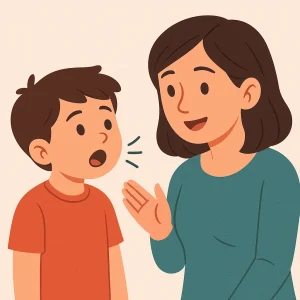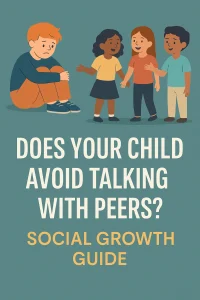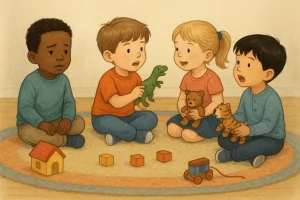Online Speech Therapy for Non-Verbal Kids: Proven Tips
By Rajini D
Last Updated: December 14, 2023
Imagine trying to communicate your needs, feelings, or thoughts without the ability to speak. For many non-verbal children, especially those on the autism spectrum, this is their daily reality. While these children often have incredible potential, their inability to use verbal speech can make expressing themselves incredibly challenging. The impact of this barrier goes beyond just communication—it affects their social interactions, emotional well-being, and overall development.
As parents and educators, you’re likely wondering: How can we help these children find their voice, even if it’s not through spoken words? That’s where speech therapy plays a crucial role. But with busy schedules and ever-evolving technology, the landscape of therapy is shifting. Online speech therapy has emerged as a game-changer, offering flexibility, accessibility, and tailored solutions for non-verbal children.
For a deeper understanding of speech and language milestones in children, visit our detailed guide here.
Understanding Non-Verbal Children
To truly support non-verbal children, it’s essential to understand their unique communication journey, which progresses through various stages. Each stage highlights a child’s evolving ability to express themselves, offering insights into how parents and therapists can best guide them.
- The Own Agenda Stage: In this early stage, children focus mainly on their own interests. They don’t interact much with others and communicate only when they need something. Their behavior is driven by fulfilling their immediate needs, like reaching for a toy or responding to something they enjoy.
Example: A child who wants a snack might simply point to the kitchen without using words. This is their way of communicating at this stage. - The Requester Stage: In the requester stage, children begin to understand that their actions can influence others. They start asking for things by leading adults to what they want or using basic gestures like pointing or pulling.
Example: If a child wants a drink, they might hand a parent an empty cup instead of using words. This shows they’re starting to communicate more actively. - The Early Communicator Stage: Here, children start to use gestures, sounds, or even words in certain situations. They may not speak clearly, but their intent to communicate is stronger. They also start interacting for longer periods.
Example: A child might lift their arms to show they want to be picked up, or clap when they are excited. These actions show they are trying to express themselves. - The Partner Stage: At this stage, children are better at communicating. They use different methods like gestures, sounds, or pictures to express what they want or feel. They might even start talking about things from the past or future.
Example: A child may show a picture of a ball when they want to play outside, or nod when asked if they are hungry. They are becoming more effective in getting their message across.
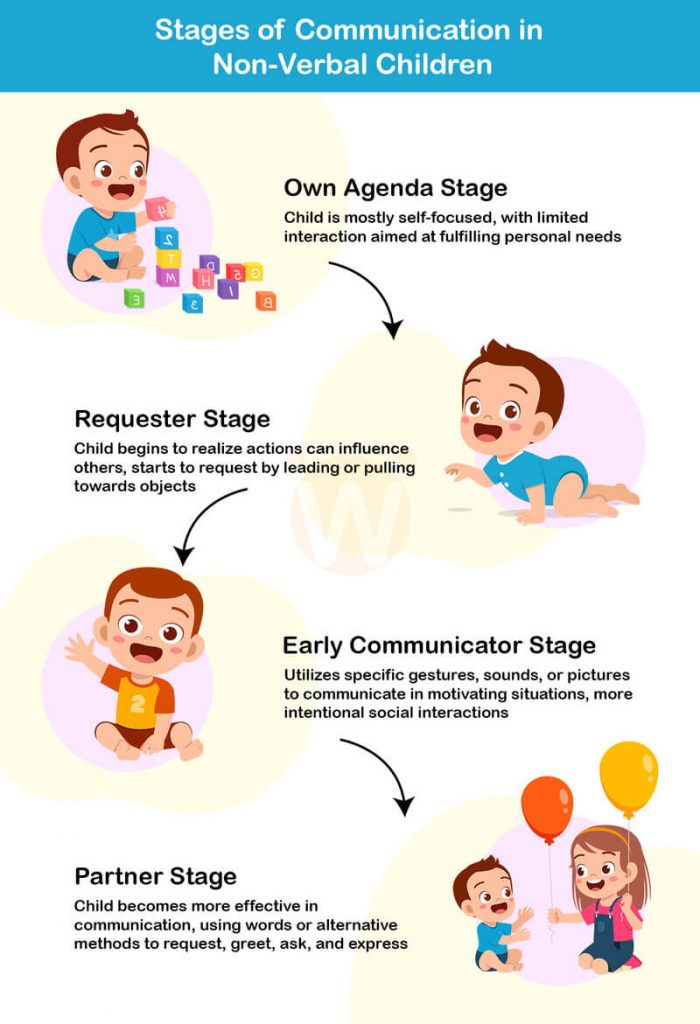
Why These Stages Matter
Knowing which stage a child is in helps parents and therapists set the right communication goals. Each stage has its own challenges, and therapy can be adapted to match the child’s needs. For instance, a child in the early stages might need simple activities that encourage interaction, while a child in the partner stage might benefit from more complex communication tasks.
Online speech therapy makes it easier to customize these approaches to fit the child’s stage of development. With tools like visual aids, games, and real-time feedback, therapists can help children build their communication skills, even from home.
Remember, every child’s journey is different. The goal is to help them communicate in whatever way works best for them, whether through words, gestures, or other methods. Online speech therapy offers flexible and effective ways to support non-verbal children on this path
Effective Strategies in Online Speech Therapy
Online speech therapy uses simple methods to help non-verbal children improve their communication skills. These strategies can easily be part of their daily routine.
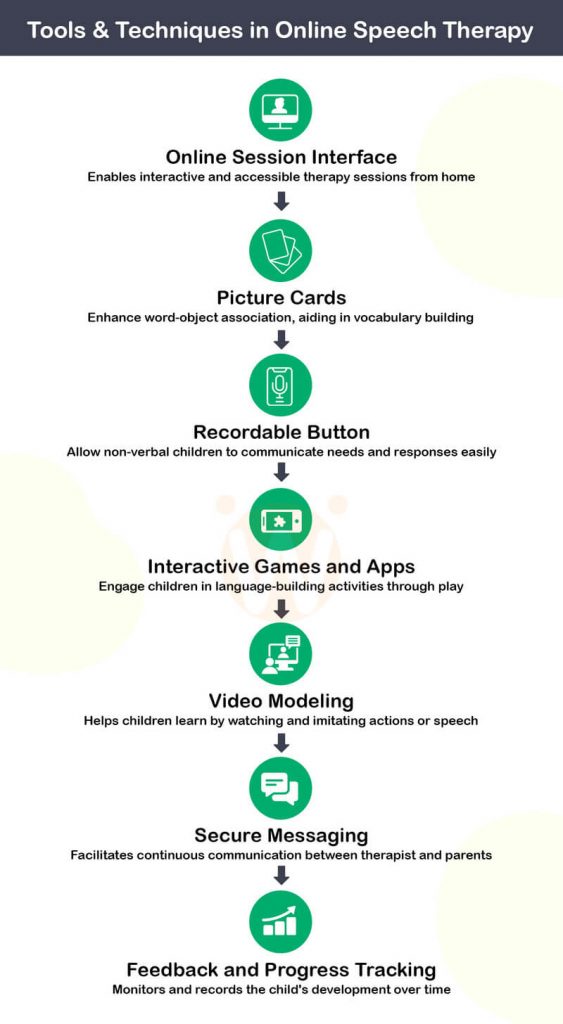
1. Imitation of Actions
Children learn to copy actions like clapping or waving. Therapists demonstrate through video, and children imitate to build communication skills.
Example: A therapist waves, and the child waves back, learning to imitate and interact.
2. Turn-Taking and Requesting
Therapy games teach children to wait for their turn and make requests, either by speaking or using gestures and picture cards.
Example: The child takes turns in a game or uses a card to ask for help.
3. Use of Picture Cues
Pictures help children learn new words and communicate. Therapists use images to teach children to connect words with objects.
Example: A therapist shows a picture of a ball, and the child points to it, learning to associate words with pictures.
4. Following Multi-Step Directions
Children learn to follow instructions with more than one step, helping them complete tasks in order.
Example: The therapist says, “Pick up the toy, then put it on the table,” and the child follows along.
5. Improving Imitation Skills
Children copy sounds and words during activities like singing or storytelling, helping develop speech.
Example: The child sings along with the therapist, copying words and sounds.
By practicing these strategies daily, children can improve communication skills naturally and easily.
Comparison of Traditional vs. Online Speech Therapy
| Feature | Traditional Therapy | Online Therapy |
|---|---|---|
| Accessibility | Often requires travel to a clinic, which can be challenging for some families. | Accessible from home, reducing travel time and making scheduling easier. |
| Flexibility | Sessions are usually scheduled during clinic hours, which may not always be convenient. | Offers more flexible scheduling, including potential for evening or weekend sessions. |
| Tools Used | Relies on physical tools and direct interaction, which can be effective but limited to the clinic’s resources. | Utilizes digital tools and resources, offering a wide range of interactive and engaging activities. |
| Parent Involvement | Parents are typically involved in the therapy process, but their role might be more observational during sessions. | Encourages active parent participation, as therapy is conducted in the home environment. |
| Environment | Conducted in a professional setting, which can be less familiar to the child. | Takes place in the child’s own environment, which can be more comfortable and less intimidating. |
| Customization | While personalized, the therapy may follow a more standardized approach due to the clinic’s protocols. | Highly customizable, with therapy sessions tailored to the child’s specific needs and home environment. |
| Technology Integration | Limited to the equipment available in the clinic. | Makes extensive use of modern technology, including apps and online resources, for interactive learning. |
| Feedback and Monitoring | Regular feedback typically provided in face-to-face meetings with parents. | Continuous and real-time feedback often available through online platforms, with progress tracking features. |
| Peer Interaction | Group therapy sessions offer peer interaction, which can be beneficial for social skills development. | Online group sessions may be available, but peer interaction could be less direct compared to in-person settings. |
The Role of Technology in Speech Therapy
Technology has changed the way speech therapy is done, especially online. With the help of different tools, therapy sessions have become more fun, interactive, and effective for non-verbal children.
- Secure Texting with Therapists: Many online speech therapy platforms let parents and therapists stay in touch through secure messaging. This allows parents to easily share updates, ask questions, and discuss their child’s progress. Being able to communicate anytime helps ensure that the child gets the support they need.
Example: A parent might send a quick message to the therapist about a new behavior they noticed, and the therapist can use that information in the next session. - Weekly Therapy Exercises: Every week, children receive activities designed just for them to practice what they’ve learned in therapy. These exercises can be done anytime, making it easy for parents to fit practice into the daily routine.
Example: A child might be assigned a fun word-matching game to practice building their vocabulary between sessions. - Recordable Button Switches: For children who are non-verbal, recordable button switches are a helpful tool. These devices let kids record short messages that can be played back to communicate their needs. It’s a great way to give non-verbal children a way to participate in conversations.
Example: A child might press a button to say “I want water,” helping parents understand what they need without any frustration. - Tracking Progress: Technology also makes it easy to keep track of a child’s progress. Many online therapy platforms offer progress-tracking tools that show how a child is improving, help set goals, and adjust therapy plans as needed.
Example: Parents and therapists might see that a child has gotten better at following instructions over time, which helps everyone celebrate those achievements and stay motivated.
At Wellness Hub, we understand the transformative power of these technological tools in speech therapy. By leveraging technology, we aim to provide children with the best possible support on their communication journey. For more information on how technology is integrated into our speech therapy sessions, visit our TELE BASICS – A Synchronized Whiteboard from Wellness Hub page.
Total Communication Approach
The Total Communication Approach in speech therapy is designed to meet the unique communication needs of non-verbal children, especially those with autism. This method doesn’t rely only on spoken language but uses a variety of non-verbal tools to help children express themselves in ways that feel natural to them.
Non-Verbal Communication Skills
Before children use words, they often rely on non-verbal cues like gestures, facial expressions, and eye contact. These prelinguistic skills are vital for early communication and are a big part of the Total Communication Approach. For many non-verbal children, using these skills is a first step toward developing their ability to interact with others.
Example: A child might point to a toy they want or use eye gaze to show interest in something. Recognizing these non-verbal cues helps parents and therapists understand the child’s needs before verbal language develops
Visual Aids: Pictures and Objects
Visual aids like pictures and real objects play a major role in this approach. They help children make connections between images and words or actions. By using pictures, children can communicate their thoughts or make choices without needing to speak.
Example: If a child is hungry, showing them pictures of different foods can help them point to what they want. This makes it easier for them to communicate without frustration.
Recordable Buttons for Simple Communication
Recordable buttons are a useful tool in the Total Communication Approach. These devices can be programmed with short messages that children can use to express basic needs, such as asking for a snack or indicating they need a break. This gives children a sense of independence and control over their interactions.
Example: A child might press a button that says “I’m thirsty” to let their parent or therapist know what they need. This simple action allows them to communicate effectively without using words.
Tailoring Communication Strategies
One of the key aspects of this approach is understanding that each child communicates differently. The Total Communication Approach recognizes that every child has their own strengths and challenges, so strategies are adjusted to fit their specific needs.
Example: Some children may prefer using pictures, while others might rely more on gestures or recordable buttons. The goal is to find what works best for each child and build on those strengths.
Focus Areas and Exercises in Speech Therapy for Non-Verbal Autism
Speech therapy for non-verbal children with autism focuses on several key areas to help them develop communication and social skills. These areas guide the exercises and activities that therapists use to support each child’s unique needs.
Encouraging Social Interactions
Therapists help children learn how to interact socially with others. This might involve exercises where children participate in group activities, recognize social cues, or engage in play with family members or peers. The goal is to help children feel more comfortable in social settings and understand how to connect with others.
Example: A therapist may use a group game where children take turns passing a ball, encouraging them to pay attention to others and wait for their turn.
Enhancing Understanding of Spoken Language
In this area, therapists focus on helping children understand spoken language. This can include teaching children to follow simple instructions, recognize everyday words, and understand verbal cues used in their daily routines.
Example: A child might be asked to point to common items like a cup or a ball when the therapist says the word, helping them connect the spoken word with the object.
Building Communication Skills
The focus here is on developing different ways for children to communicate. This could involve using signs, picture symbols, or alternative communication devices like speech-generating apps. These methods give non-verbal children a way to express themselves even if they don’t use spoken words.
Example: A child might use a tablet with pictures to ask for a snack by selecting the image of the food they want.
Examples of Speech Therapy Exercises
Journaling
In this exercise, children express their thoughts and feelings through drawing or writing in journals. This helps them develop self-expression and can be a bridge to more advanced communication skills.
Example: A child might draw a picture of their favorite activity, which they can later show to a parent or therapist to talk about what they enjoy doing.
Name Games
These games are designed to help children recognize and respond to their own names, which is an important step in understanding identity and building connections with others.
Example: A therapist might play a game where they call out the child’s name during an activity, and the child is encouraged to respond by raising their hand or looking toward the therapist.
Speech Therapy Exercises for Non-Verbal Autism
| Exercise | Description | Targeted Skill |
|---|---|---|
| Journaling | Encourages children to express thoughts and feelings through drawing or writing in a journal. | Expression, Conceptualization, Writing Skills |
| Name Games | Games designed to help children recognize and respond to their names. | Listening, Recognition, Response to Stimuli |
| Picture Cues | Uses images to convey meaning or to associate words with objects/actions. | Comprehension, Vocabulary, Association |
| Turn-Taking Games | Activities where the child learns to wait and take turns, often through digital or physical games. | Social Skills, Patience, Sequential Understanding |
| Imitation Activities | Engaging the child in mimicking actions, sounds, or words. | Speech Production, Motor Skills, Auditory Processing |
| Gesture-Based Communication | Incorporates gestures or sign language to communicate needs or responses. | Non-Verbal Communication, Motor Coordination |
| Role-Playing | Involves scenarios or role-play to encourage verbalization and interaction. | Social Interaction, Verbal Expression, Creativity |
| Sound Repetition | Focuses on repeating sounds or words, often with the aid of visual or auditory cues. | Speech Clarity, Auditory Discrimination, Memory |
| Object Identification | Uses real objects to teach children to identify and name various items. | Vocabulary Building, Object Recognition, Memory |
| Interactive Storytelling | Involves reading or creating stories together, encouraging participation. | Listening, Comprehension, Imagination |
The Importance of Early Intervention in Speech Therapy
Starting speech therapy early is very important for children with communication challenges, especially non-verbal children, including those with autism. The sooner they begin therapy, the better their chances of improving communication, social skills, and learning.

Why Early Intervention Matters
Starting therapy early gives children more time to develop important communication skills. This helps them become more confident in expressing their needs and emotions, leading to better social interactions and learning outcomes.
Example: A child who begins therapy early might learn to use picture cards to ask for help or express feelings. Over time, this skill can grow into more complex forms of communication.
Why Early Intervention Helps
When children get therapy early, they have more time to learn how to express themselves. This helps them feel more confident and communicate better with others.
Example: A child who starts therapy early might use picture cards to show what they want. Over time, this skill can grow into more advanced ways of communicating.
The Role of Parents and Educators
Parents and teachers play a big role in helping children practice what they learn in therapy. By using therapy strategies at home and in school, they help children improve faster.
Example: Parents can use pictures during daily activities to help the child make choices, and teachers can give simple instructions in class to support their learning.
With regular practice at home and in school, children can naturally build their communication skills over time.
Conclusion
Early speech therapy is crucial for non-verbal children, especially those with autism. Starting therapy early gives them more time to develop key communication skills, boosting their confidence in expressing needs and emotions. Parents and educators can make a big impact by practicing therapy techniques at home and in school. Simple tools like picture cards, role-playing, and imitation games are easy to integrate. At Wellness Hub, we provide customized, interactive online speech therapy to support your child’s growth. With consistent practice and our expert guidance, children can strengthen their social and communication skills over time. Learn more in our speech therapy guide for autism.
Frequently Asked Questions:
1. What is online speech therapy for non-verbal children?
Online speech therapy helps non-verbal children improve communication skills using virtual sessions. Therapists guide children through exercises using games, visual aids, and technology, all from the comfort of home.
2. How effective is online speech therapy compared to traditional in-person therapy?
Numerous studies have shown that online speech therapy can be just as effective as traditional in-person therapy for many children. It offers flexibility, accessibility, and often a more comfortable environment for the child.
3. What age is appropriate to start speech therapy for a non-verbal child?
There’s no minimum age to start speech therapy. In fact, early intervention, often starting as young as infancy, is recommended for better outcomes, especially for children showing signs of communication delays.
4. Can parents and educators be involved in online speech therapy sessions?
Absolutely. Parent and educator involvement is encouraged in online speech therapy. They play a crucial role in reinforcing the strategies and exercises introduced during therapy sessions.
5. What are some common strategies used in speech therapy for non-verbal children?
Common strategies include the use of picture cues, imitation of actions, turn-taking, and utilizing assistive technologies like recordable button switches.
6. How does the Total Communication Approach help non-verbal children?
The Total Communication Approach uses a combination of methods including gestures, facial expressions, sign language, and technology to enhance communication. It’s tailored to each child’s unique needs and strengths.
7. What role does technology play in online speech therapy?
Technology in online speech therapy includes tools like secure messaging with therapists, digital exercises, and interactive games, all of which enhance the learning experience and track progress.
8. How can I assess if my child is making progress in online speech therapy?
Progress can be monitored through regular assessments by the therapist, observing improvements in daily communication, and tracking achievements in specific therapy goals.
9. Are there any specific exercises to help non-verbal children in speech therapy?
Yes, exercises like journaling, name games, and structured play activities are often used to enhance communication skills in non-verbal children.
10. Where can I find more resources and support for speech therapy for non-verbal children?
WellnessHub offers a range of resources, support, and information for parents and educators involved in speech therapy for non-verbal children. Visit our website here for more information.
About the Author:
Rajini Darugupally
M.Sc., Speech-Language Pathologist (9+ years of experience)
Rajini is a passionate and dedicated Speech-Language Pathologist with over 9+ years of experience, specializing in both developmental speech and language disorders in children and rehabilitation in adults. Driven by a desire to empower each individual to find their voice, Rajini brings a wealth of experience and a warm, genuine approach to therapy. Currently, at Wellness Hub, she thrives in a team environment that values innovation, compassion, and achieving results for their clients.
Book your Free Consultation Today
Parent/Caregiver Info:
Client’s Details:
* Error Message
